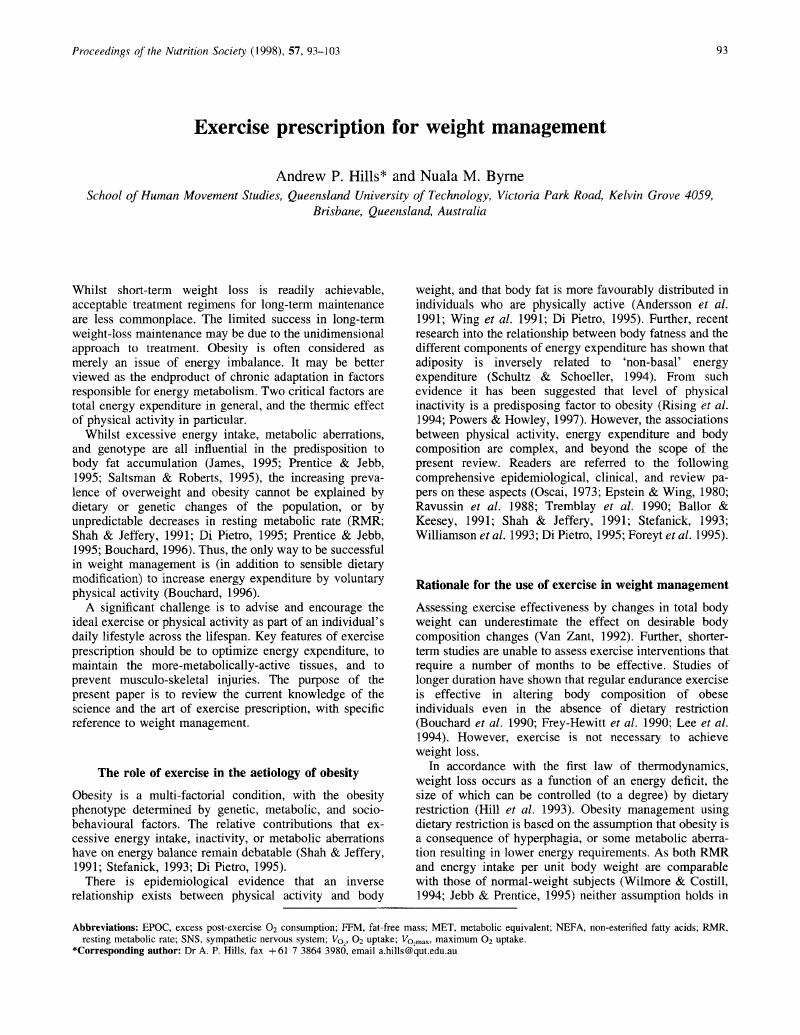Crossref Citations
This article has been cited by the following publications. This list is generated based on data provided by Crossref.
Martinez, J. Alfredo
2000.
Body-weight regulation: causes of obesity.
Proceedings of the Nutrition Society,
Vol. 59,
Issue. 3,
p.
337.
Sothern, Melinda S.
2001.
EXERCISE AS A MODALITY IN THE TREATMENT OF CHILDHOOD OBESITY.
Pediatric Clinics of North America,
Vol. 48,
Issue. 4,
p.
995.
BYRNE, NUALA M.
and
HILLS, ANDREW P.
2002.
Relationships between HR and &OV0312;O2 in the obese.
Medicine & Science in Sports & Exercise,
Vol. 34,
Issue. 9,
p.
1419.
Hills, A. P.
Hennig, E. M.
Byrne, N. M.
and
Steele, J. R.
2002.
The biomechanics of adiposity – structural and functional limitations of obesity and implications for movement.
Obesity Reviews,
Vol. 3,
Issue. 1,
p.
35.
Deforche, Benedicte
Lefevre, Johan
De Bourdeaudhuij, Ilse
Hills, Andrew P.
Duquet, William
and
Bouckaert, Jacques
2003.
Physical Fitness and Physical Activity in Obese and Nonobese Flemish Youth.
Obesity Research,
Vol. 11,
Issue. 3,
p.
434.
Sharpe, Jenny-Kay
and
Hills, Andrew P.
2003.
Atypical antipsychotic weight gain: a major clinical challenge.
Australian and New Zealand Journal of Psychiatry,
Vol. 37,
Issue. 6,
p.
705.
Sharpe, Jenny-Kay
and
Hills, Andrew P.
2003.
Atypical Antipsychotic Weight Gain: A Major Clinical Challenge.
Australian & New Zealand Journal of Psychiatry,
Vol. 37,
Issue. 6,
p.
705.
Speakman, John R.
and
Selman, Colin
2003.
Physical activity and resting metabolic rate.
Proceedings of the Nutrition Society,
Vol. 62,
Issue. 3,
p.
621.
Hills, Andrew P.
and
Byrne, Nuala M.
2004.
Physical activity in the management of obesity.
Clinics in Dermatology,
Vol. 22,
Issue. 4,
p.
315.
Bircher, Stefan
Knechtle, Beat
Müller, Gabi
and
Knecht, Hans
2005.
Is the highest fat oxidation rate coincident with the anaerobic threshold in obese women and men?.
European Journal of Sport Science,
Vol. 5,
Issue. 2,
p.
79.
Maffiuletti, N A
Agosti, F
Marinone, P G
Silvestri, G
Lafortuna, C L
and
Sartorio, A
2005.
Changes in body composition, physical performance and cardiovascular risk factors after a 3-week integrated body weight reduction program and after 1-y follow-up in severely obese men and women.
European Journal of Clinical Nutrition,
Vol. 59,
Issue. 5,
p.
685.
Sherwood, Nancy E
Martinson, Brian C
Crain, A Lauren
Hayes, Marcia G
Pronk, Nicolaas P
and
O'Connor, Patrick J
2008.
A new approach to physical activity maintenance: Rationale, design, and baseline data from the Keep Active Minnesota trial.
BMC Geriatrics,
Vol. 8,
Issue. 1,
Hills, Andrew
P.
Byrne, Nuala
M.
and
Wood, Rachel
E.
2008.
Paediatric Exercise Science and Medicine.
p.
453.
Martinson, Brian C.
Crain, A. Lauren
Sherwood, Nancy E.
Hayes, Marcia
Pronk, Nico P.
and
O'Connor, Patrick J.
2008.
Maintaining physical activity among older adults: Six-month outcomes of the Keep Active Minnesota randomized controlled trial.
Preventive Medicine,
Vol. 46,
Issue. 2,
p.
111.
Tiruneh, Gizachew
2009.
The relation between physical activity and body mass index: Issues in model specification.
International Journal on Disability and Human Development,
Vol. 8,
Issue. 3,
King, Neil
Byrne, Nuala M.
Hunt, Andrew
and
Hills, Andrew
2010.
Comparing exercise prescribed with exercise completed: Effects of gender and mode of exercise.
Journal of Sports Sciences,
Vol. 28,
Issue. 6,
p.
633.
BEA, JENNIFER W.
CUSSLER, ELLEN C.
GOING, SCOTT B.
BLEW, ROBERT M.
METCALFE, LAUVE L.
and
LOHMAN, TIMOTHY G.
2010.
Resistance Training Predicts 6-yr Body Composition Change in Postmenopausal Women.
Medicine & Science in Sports & Exercise,
Vol. 42,
Issue. 7,
p.
1286.
Fenzl, Navina
Bartsch, Katja
and
Koenigstorfer, Joerg
2014.
Labeling exercise fat-burning increases post-exercise food consumption in self-imposed exercisers.
Appetite,
Vol. 81,
Issue. ,
p.
1.
Monnard, Cathríona R.
Miles-Chan, Jennifer L.
and
Taheri, Shahrad
2017.
Energy Cost of Standing in a Multi-Ethnic Cohort: Are Energy-Savers a Minority or the Majority?.
PLOS ONE,
Vol. 12,
Issue. 1,
p.
e0169478.
Armstrong, Neil
van Mechelen, Willem
Hills, Andrew P
Street, Steven J
and
Byrne, Nuala M
2017.
Oxford Textbook of Children's Sport and Exercise Medicine.
p.
347.



